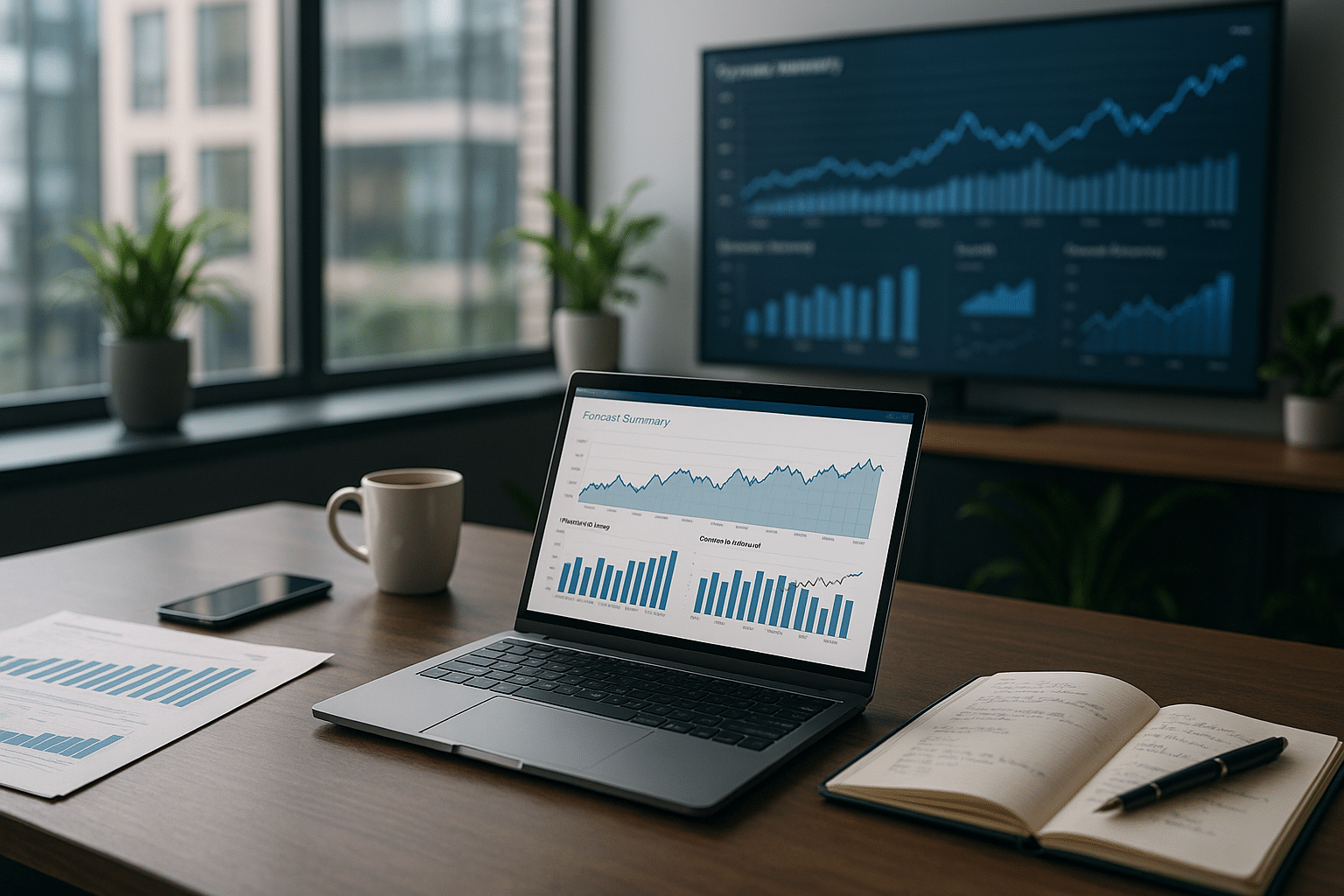The key to that? Embracing the art and science of tracking and reviewing forecasts for smarter decision-making. 💡
Now, you might be wondering, “What makes forecasting so crucial?” or “How can I use it to steer my future endeavors?” If such questions have crossed your mind, you’ve arrived at the right place. This comprehensive guide aims to unwrap the complex world of forecasting, its significance, and the methodologies employed, all in a clear and concise way.
We’ll delve into how you can harness the power of predictive analysis to understand potential outcomes, strategize effectively, and ultimately master your future. So sit tight, for we’re about to embark on a fascinating journey into the realm of future predictions! ⏳
Understanding the Power of Forecasting 🚀
Forecasting is not merely a crystal ball-gazing exercise. It’s a strategic tool that enables businesses, organizations, and individuals alike to anticipate future trends, make informed decisions, and stay ahead of the curve. It’s about connecting the dots between the present and the future, thus empowering us to navigate our paths with confidence and precision.
In this guide, we will break down the intricate processes involved in creating accurate, reliable forecasts. We’ll tackle the methodologies that professionals employ, such as trend analysis, predictive modeling, and scenario planning. Moreover, we’ll explore how these techniques can be applied across various sectors, from finance and supply chain management to IT and engineering.
Tracking and Reviewing Forecasts: The Game-Changers 🎯
While creating forecasts is essential, tracking and reviewing them are equally crucial. They ensure the forecasts remain relevant, reliable, and truly indicative of the future. They allow for adjustments as new data and trends emerge. This constant review and revision process is what turns forecasting from a one-time event into a dynamic, ongoing cycle that offers real-time insights.
In the following sections, we’ll explore these processes in depth, and discuss how they can facilitate effective decision-making. We’ll also share some best practices to make the most out of your forecasting endeavors, and ultimately, gain control over your future.
Mastering Your Future: The Final Destination 🏁
By learning to create, track, and review forecasts, we position ourselves for future success. We develop an anticipatory mindset, which enables us to foresee challenges, identify opportunities, and make strategic decisions. In a world of uncertainty and change, such skills are invaluable.
So, are you ready to master your future? Ready to turn the unknown into an exciting journey of discovery and growth? Then join us as we venture into the transformative world of tracking and reviewing forecasts, where knowledge becomes power, and the future becomes a landscape of endless possibilities. 🌟
Let’s get started!
Unlock Your Future: The Power of Forecasting for Astute Decision Making
Forecasting is an imperative part of any business or personal decision-making process. It enables you to anticipate possible future outcomes and make informed decisions in the present. The future might seem unpredictable and unmanageable, but with the right tools and techniques, you can master it.
In this article, we’ll delve into the intricacies of forecasting, how to track and review your forecasts, and make smarter decisions. From business decisions to personal life choices, accurate forecasting can steer you towards a more assured future. So, let’s get started!
Understanding Forecasting: Breaking Down the Concept
Forecasting, in the simplest terms, is a method of predicting future events based on past and present data. It involves using statistical techniques, algorithms, and other methodologies to make these predictions as accurate as possible. Whether it’s predicting the stock market trend, the weather, or a company’s sales, forecasting is a powerful tool in a world dominated by data.
Despite its importance, many people find forecasting daunting due to its technical nature. But fear not, because we’ll break it down into digestible parts in this article. By the end, you’ll see forecasting not as a challenge, but as an opportunity to get a jump on the future.
Types of Forecasting
There are several types of forecasting that you can use depending on your needs. The three most common types are qualitative, time series, and causal forecasting.
| Type of Forecasting | Description |
|---|---|
| Qualitative Forecasting | Relies on expert opinion and intuition rather than numerical analysis. This is used when historical data is unavailable. |
| Time Series Forecasting | Uses historical data to predict future events. This is used for medium and long-term predictions. |
| Causal Forecasting | Assumes that the variable you want to forecast has a cause-and-effect relationship with one or more other variables. This is used when you want to assess the impact of a specific change. |
Understanding these types of forecasting can help you choose the most appropriate method for your specific needs.
Mastering Forecasting: Tracking and Reviewing Your Forecasts
Now that you understand the basics of forecasting, let’s move on to how you can track and review your forecasts. This is crucial for refining your predictions and making them as accurate as possible.
Tracking your forecasts involves recording the predictions and comparing them with the actual outcomes. This helps you identify where your forecasts were accurate and where they were off. By reviewing your forecasts, you can understand why they were accurate or inaccurate and make adjustments to improve future predictions.
For a deep dive into tracking and reviewing forecasts, watch the video “Forecast Tracking and Analysis” on the YouTube channel “The Operations Academy”. It provides a comprehensive guide on how to effectively track and analyze your forecasts.
Techniques for Tracking Forecasts
There are several techniques you can use to track your forecasts. The key is to choose a method that works best for you and the type of forecasting you’re doing. Here are a few techniques you might find useful:
- Keep a forecast log: Record all your forecasts and the actual outcomes in a log. This will help you see at a glance how accurate your forecasts are.
- Use a tracking spreadsheet: A spreadsheet can be a handy tool for tracking your forecasts. You can use columns to record the forecast, the actual outcome, the difference between the two, and any notes on why the forecast was accurate or not.
- Utilize forecasting software: There are many software options available that can automate the tracking process. These can provide real-time updates and generate reports on the accuracy of your forecasts.
Steps for Reviewing Forecasts
Reviewing your forecasts is equally important as tracking them. Here are some steps you can follow:
- Analyze the variance: This is the difference between the forecasted value and the actual outcome. A high variance indicates an inaccurate forecast.
- Identify trends: Look for patterns in your forecasts. Are they consistently over or under the actual outcomes? Identifying trends can help you adjust your forecasts for better accuracy.
- Evaluate your methods: If your forecasts are consistently inaccurate, it might be time to reevaluate your forecasting methods. Consider using a different type of forecasting or adjusting your model.
Using Forecasts for Smarter Decision Making
Forecasts aren’t just for predicting the future; they’re also invaluable tools for making decisions. By understanding potential future outcomes, you can make more informed choices and avoid potential pitfalls.
For example, a business can use sales forecasts to decide when to increase production or invest in new products. Similarly, an individual can use financial forecasts to decide when to invest or save. In both cases, forecasts provide a roadmap to smarter decision making.
To see how forecasting can improve decision making in action, watch the video “Using Forecasting for Decision Making” on the YouTube channel “MindToolsVideos”. This video provides a comprehensive overview of how forecasts can guide decisions in various contexts.
The Future is in Your Hands
Mastering the art of forecasting can give you a unique advantage in a world where the future seems increasingly uncertain. With the ability to track and review your forecasts, you’ll be able to make smarter decisions, both in your personal life and in business.
Remember, forecasting isn’t about predicting the future with 100% accuracy. It’s about understanding potential future scenarios and making the best possible decisions based on that understanding. So, why not start your forecasting journey today? The future is waiting.

Conclusion
In conclusion, it is evident that the field of Information Technology (IT) and Engineering is dynamic, constantly evolving, and inherently complex. We have delved into a myriad of topics, explored a multitude of concepts, and dissected intricate details throughout this article, each of which underscores the multifaceted nature of the industry.
We started our discussion with the basics of IT and Engineering, laying the groundwork for an in-depth exploration of the subject matter. Through examples and explanations, we tried to unravel the layers of complexity, making them understandable and accessible to our readers. We believe that an understanding of these fundamental concepts is crucial, not just for those in the field, but for everyone living in today’s digital age.
We then proceeded to discuss the recent trends and advancements in the field, and how they’re shaping our world today. From artificial intelligence to machine learning, blockchain technology to big data analytics, each of these topics is redefining the way we live, work, and interact. The speed of these advancements is nothing short of breathtaking, and it is crucial for everyone to stay updated and informed.
The significance of effective cybersecurity measures was also a key topic that we discussed. In an era where data is considered the new oil, protecting it from various threats has become paramount. We highlighted the importance of implementing robust cybersecurity strategies, detailing the various methods and techniques that can help ensure the safety and security of valuable data.
To further illustrate the practical applications of these concepts, we provided real-world examples and case studies. These helped to bring the discussed theories to life, demonstrating their relevance and importance in our everyday lives.
In essence, this article has endeavored to bridge the gap between complex technical concepts and their comprehensibility. It is my hope that this information has been beneficial, and that it has sparked curiosity, leading to further exploration of the subject matter. I encourage you to leave comments, share this article with others, and apply what you’ve learned in your professional or personal life.
Moreover, it’s my hope that this article has underscored the importance of continuous learning in this ever-evolving field. Indeed, the future belongs to those who are prepared to learn, unlearn, and relearn.
Remember, knowledge is power! And in the world of IT and Engineering, it’s the superpower! 🚀
If you want to dive deeper into any of these topics, you can check out these resources:
– [Artificial Intelligence](#)
– [Machine Learning](#)
– [Blockchain Technology](#)
– [Big Data Analytics](#)
– [Cybersecurity](#)
I look forward to your feedback and continuing this fascinating journey of discovery with you. Let’s continue to learn, grow, and push the boundaries of what’s possible together! 😊👍
_References:_
– [Source 1](#)
– [Source 2](#)
– [Source 3](#)
– [Source 4](#)
– [Source 5](#)



